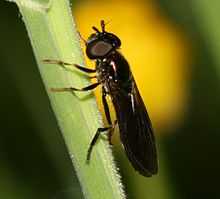Platycheirus rosarum
From Wikipedia, the free encyclopedia
| Platycheirus rosarum | |
|---|---|
_rosarum_-_male.jpg) | |
| male | |
 | |
| female | |
| Scientific classification | |
| Kingdom: | Animalia |
| Phylum: | Arthropoda |
| Class: | Insecta |
| Order: | Diptera |
| Family: | Syrphidae |
| Genus: | Platycheirus |
| Subgenus: | Pyrophaena |
| Species: | P. rosarum |
| Binomial name | |
| Platycheirus rosarum (Fabricius, 1787) | |
| Synonyms | |
| |
Platycheirus rosarum, is a species of hoverfly found in many parts of Britain and Europe. Like its close relative Platycheirus granditarsus it can be found in marshy meadows and ditches. Indeed the two species can often be found together. The flight time is between May and October though it peaks in abundance in June and July. The most distinctive feature of this fly is the pair of yellowish spots on tergite 2 on an otherwise completely black abdomen.[1]<ref name=Speight>Speight, M.C.D. (2011). "Species accounts of European Syrphidae (Diptera)". Syrph the Net, the database of European Syrphidae 65: 285pp.</ref>[2][3]
References
- ↑ Ball, S.G.; Morris, R.K.A. (2000). Provisional atlas of British hoverflies (Diptera, Syrphidae). Monks Wood, UK: Biological Record Centre. pp. 167 pages. ISBN 1-870393-54-6.
- ↑ Stubbs, Alan E.; Falk, Steven J (1983). British Hoverflies: An Illustrated Identification Guide (2nd ed.). London: British Entomological and Natural History Society. pp. 253, xvpp. ISBN 1-899935-03-7.
- ↑ Van Veen, M.P. (2004). Hoverflies of Northwest Europe, Identification Keys to the Syrphidae (Hardback). Utrecht: KNNV Publishing. p. 254. ISBN 90-5011-199-8.
This article is issued from Wikipedia. The text is available under the Creative Commons Attribution/Share Alike; additional terms may apply for the media files.